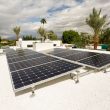Report: Oregon can dramatically reduce its climate footprint, save money, by transitioning to heat pumps
As temperatures heat up, communities across the United States are working hard to sever their reliance on fossil fuels and reduce their climate footprint. Policies intended to curb emissions span the gamut, but most center around a fundamental shift toward clean energy. An analysis from the environmental organization the Sierra Club outlines how, as a state, Oregon could dramatically reduce its climate footprint and save taxpayers a substantial amount of money by quickly adopting a green energy appliance—heat pumps.
“A rapid transition to highly efficient electric heat pumps for heating and cooling in Oregon homes and buildings would lower household energy bills, generate $1.1 billion in system-wide savings by 2050, and dramatically reduce climate pollution—all without major grid impacts,” reads a statement about the findings issued by the Sierra Club, citing a commissioned report released recently by Synapse Energy Economics.
The report, which models the impact on economic, climate and grid of a mass-switch to heat pumps, maps two paths to the state’s emissions goals (to reduce emissions by at least 25 percent below 1990 emissions levels by 2035, and at least 80 percent below 1990 emissions levels by 2050): the first, achieving 100 percent zero-emission appliance sales by 2025, and the other by 2030.
“A 2025 implementation date would cut climate pollution from residential homes 56 percent by 2035 compared to 1990s levels and just shy of 100 percent by 2050,” the statement notes. The second, “A 2030 implementation date would cut climate pollution 47 percent by 2035, while achieving similar 2050 reductions.”
For the analysis, Synapse used a building decarbonization calculator to predict consumption demands for space heating, water heating, cooking and drying systems. Then, researchers calculated the emissions impacts of these system changes. While Oregon-focused, the study is notable to city and county administrators across the United States looking to reduce their climate footprint because of its specific focus on heat pumps, which can heat structures by transferring thermal energy from the outside indoors via a refrigeration cycle. They’re becoming increasingly popular because of their efficiency and cost effectiveness.
“Our study is one of the first to model what a rapid transition to electric heating heat pumps in Oregon could mean for the state’s electricity grid. We show that rapid adoption of these high-efficiency systems reduces winter peak demand from Oregon homes, and that overall peaks grow slowly, around half a percent per year, which is consistent with past and projected growth rates for annual total electricity loads,” said Kenji Takahashi, the lead author of the report and senior associate with Synapse.
Currently, Oregon has 1.6 million households, with 87 percent residing in the western part of the state and 13 percent in the other half. Single family homes comprise about 74 percent of all residential homes. Of those, most are heated primarily by electricity (50 percent), followed by gas (39 percent), wood (8 percent), oil and propane (2 percent). Water is mostly heated by electricity (52 percent) or gas (47 percent). But while electricity might be the primary energy source, heat pumps operate much more efficiently than other systems—the report estimates that heat pumps are 330 percent more efficient at cooling spaces than window air conditioning units. And because they’re so efficient, the grid wouldn’t see a substantial increase in demand.
“Buildings are one of Oregon’s fastest growing sources of climate emissions. Repowering our buildings to run on clean, high-efficiency, and affordable electric appliances is a key solution for avoiding the worst impacts of climate change, while uplifting resilience in the face of climate-fueled heat waves,” said Alessandra de la Torre, director of advocacy and programs at Rogue Climate, an Oregon-based climate advocacy organization. “The findings from this report make it more clear than ever that we should be investing in technology that truly brings benefits to communities that need it the most.”
To that end, the analysis specifically models the impact on climate footprint of switching to efficient heat pumps on constituents’ energy bills in two cities, Portland and Bend, to estimate how a state-wide transition would be felt by constituents.
“In Portland, the report found that households that electrify will save $161 annually on energy bills compared to homes that burn gas, and in Bend, the report projected $192 in annual savings,” the statement says.
But while there are annual savings projected, they might not be felt right away. Under the first path, a 2025 implementation data, the report projects that electrification of buildings will begin to yield system savings in 2023, and reach $290 million in savings annually by 2050. Under a 2030 implementation date, the report projects that electrification would begin reducing total system costs beginning in 2030, and achieve annual cost savings of roughly $280 million by 2050.
”We know that the transition away from fossil fuel appliances for heating has to happen to avoid the most catastrophic consequences of climate change,” said Dylan Plummer, senior campaign representative for the Sierra Club. “But even if you look at this issue from purely from an economic perspective, transitioning our homes off of polluting fuels like methane gas is still the right decision.”




















